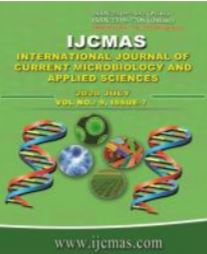


 National Academy of Agricultural Sciences (NAAS)
National Academy of Agricultural Sciences (NAAS)

|
PRINT ISSN : 2319-7692
Online ISSN : 2319-7706 Issues : 12 per year Publisher : Excellent Publishers Email : editorijcmas@gmail.com / submit@ijcmas.com Editor-in-chief: Dr.M.Prakash Index Copernicus ICV 2018: 95.39 NAAS RATING 2020: 5.38 |
One hundred rice genotypes were analyzed to evaluate the genetic polymorphism and identification of resistant lines to bacterial leaf blight (BLB) disease caused by Xanthomonas oryzae pv. oryzae using simple sequences repeat (SSR) markers. A total of 38 alleles were detected by seven polymorphic markers showing highly polymorphic across all genotypes with an average of 5.42 alleles per polymorphic marker. The marker RM-21, RM-122 and RM-224 produced maximum 6 alleles. The PIC values ranged from 0.345 to 0.688 and marker RM-21 was found to be the most appropriate marker to discriminate BLB resistant rice genotypes owing to the highest PIC value of 0.688. The cluster analysis showed that these genotypes grouped into four clusters, in which cluster IV had maximum forty genotypes followed by cluster III and cluster I. Multiple resistance ® genes (Xa21+ xa13+xa5+Xa4) were identified in germplasms such as Dhalakeera, Swarnamasuri, Purple puttu, Veethiruppu showing high level of resistance to BLB, while Navarai black 5571and Kalyani were found to be moderately resistant to BLB disease in both field and controlled condition. These genetically diverse BLB resistant genotypes can be directly utilized in rice BLB resistance breeding programs.
 |
 |
 |
 |
 |